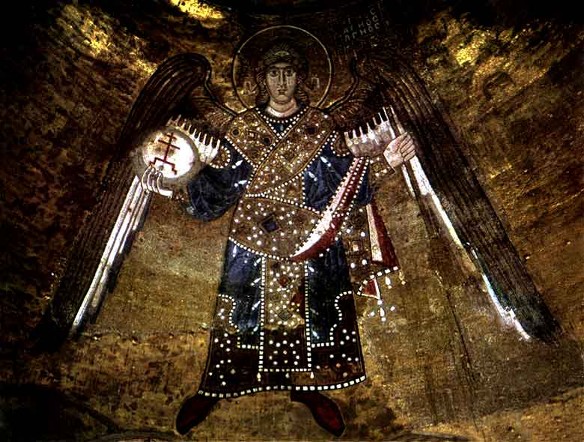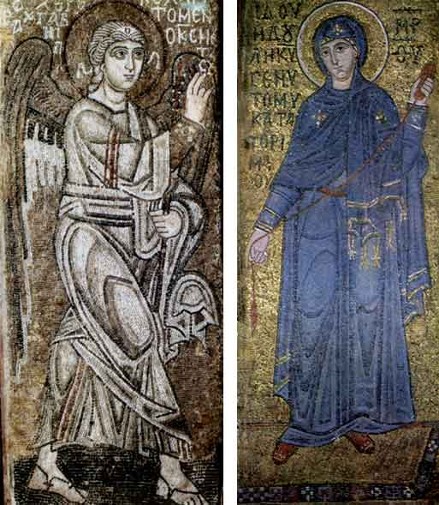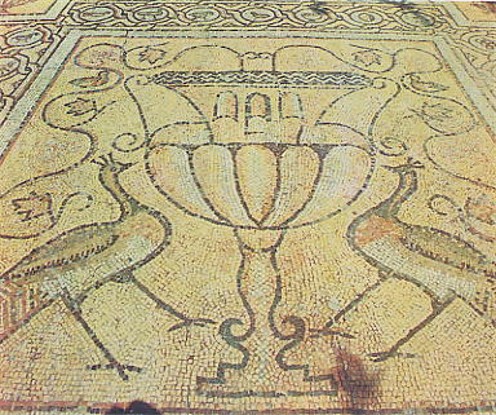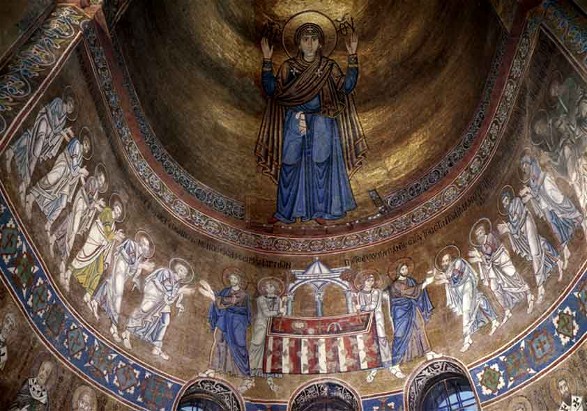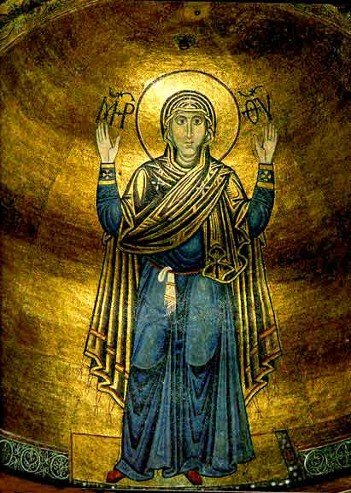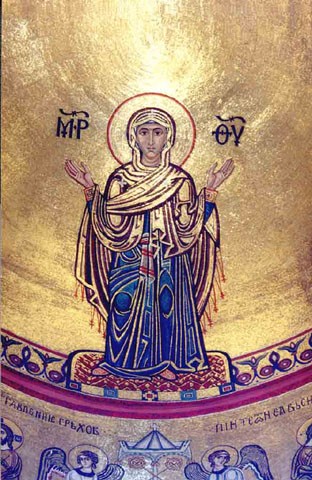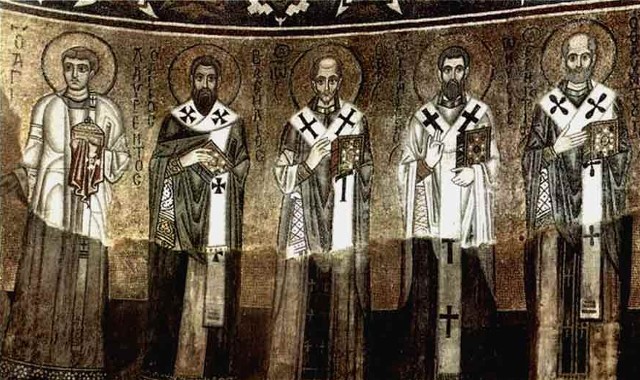Mosaic
Mosaic. A method of wall and floor decoration in which small pieces of cut stone, glass (tesserae), and, occasionally, ceramic or other imperishable materials are set into plaster, cement, or waterproof mastic.
The earliest existing examples of mosaics in Ukraine are fragments from the floor of a domestic bath found at the site of the Greek colony of Chersonese Taurica (ca 3rd–2nd century BC). Made of various colored pebbles, the floor depicts two nude figures and decorative motifs (see photo).
Mosaic was used to decorate various Rus’ churches and palaces in the 10th to 12th centuries, including the Church of the Tithes (989–96), the Saint Sophia Cathedral (1037 to the late 1040s), the Dormition Cathedral of the Kyivan Cave Monastery (1078), and Saint Michael's Church (1108–13) of the Saint Michael's Golden-Domed Monastery. Only fragments of the mosaic floors in the Church of the Tithes have been preserved (photo: mosaic floors at the Church of the Tithes), and no mosaics from the Dormition Cathedral are extant. Saint Michael's Church was destroyed in 1934–6, but fragments of its mosaics have been preserved in the Tretiakov Gallery in Moscow or installed in the choir balcony of the Saint Sophia Cathedral, which also contains the only in situ extant mosaics from the Kyivan Rus’ period (260 sq m of 640 sq m of wall space originally decorated). The Saint Sophia mosaics are made of tesserae of 18 hues in 143 tonal variations and of 25 colors of gold and silver (eg, Christ the Priest). Because the mosaics show two manners, one strongly reminiscent of the Constantinople school (see Byzantine art) and the other of a local Kyivan style, it is likely that the work was carried out by a team of Greek craftsmen with the aid of local masters.
The mosaics of Saint Michael's Church of the Saint Michael's Golden-Domed Monastery show the development of a Kyivan style that is more dynamic and compositionally less schematic than that of the Saint Sophia mosaics. In the rendering of the Eucharist in the Saint Sophia Cathedral (photo: Eucharist) the Apostles are uniformly posed and robed in subdued tones. In the Saint Michael's version of this subject the Apostles are depicted in a variety of more naturalistic poses and garbed in bright colors. The mosaics of Saint Michael's tend to be linear in style, whereas the Saint Sophia mosaics are modeled with subtle variations in tone and hue.
Because of high production costs and changing aesthetics mosaic was rarely used in large-scale murals after the 13th century. In the 17th, 18th, and 19th centuries it was used as a decorative architectural element.
In 1937 the Mosaics Workshop was formed at the Kyiv State Art Institute. In keeping with the socialist-realist penchant large-scale mosaics have been extensively used to adorn numerous public sights. Their style ranges from the pedantic realism of such artists as Vasyl Ovchynnykov (Mother Nursing Her Child, on an apartment building in Kyiv) and Stepan Kyrychenko and N. Klein (Harvest, 1957) to the stylized joint works of A. Rybachuk and V. Melnychenko (mosaic mural in the Kyiv Palace of Pioneers and Schoolchildren, 1965) and E. Kotkov, Valerii Lamakh, and Ivan Lytovchenko (Peace, Work, and Happiness, in the Boryspil Airport, 1965). Many of the large mosaic murals, particularly on the exteriors of buildings, are made from a variety of materials, including ceramic tiles and pieces of sculpted colored cement.
Emigré artists, such as Volodymyr Balias, Mykhailo Dmytrenko, Petro Kholodny, and Petro P. Kholodny, have employed the mosaic medium on a limited scale. The most notable example of mosaic in Ukrainian émigré art is the neo-Byzantine (see Neo-Byzantinism) mural in the Saint Sophia Cathedral in Rome designed by Sviatoslav Hordynsky.
BIBLIOGRAPHY
Lobanovs’kyi, B. Mozaïka i freska (Kyiv 1966)
Popova, L. Ukraïns’kyi radians’kyi monumental’nyi zhyvopys (Kyiv 1973)
Garkusha, N.; et al. Monumental’noe i dekorativnoe iskusstvo v arkhitekture Ukrainy (Kyiv 1975)
Nestor Mykytyn
[This article originally appeared in the Encyclopedia of Ukraine, vol. 3 (1993).]
